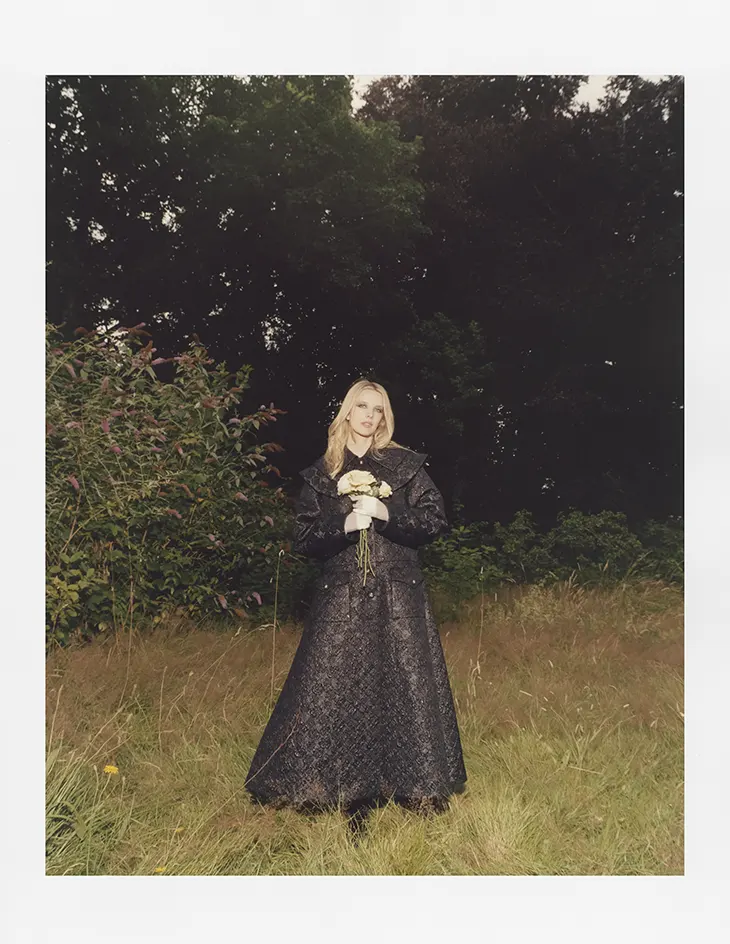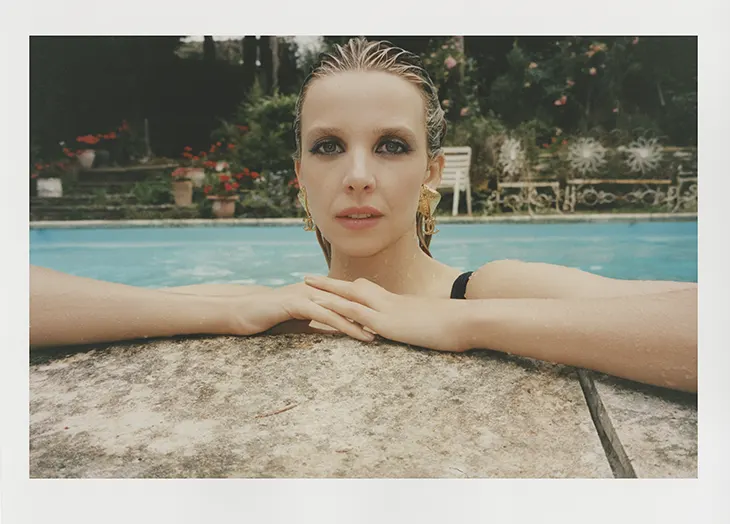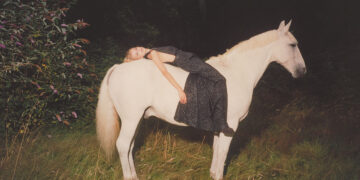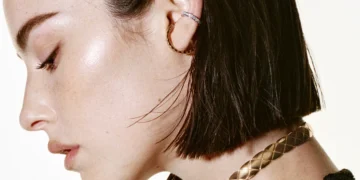 Intertwining poetry with performance, Greta Bellamacina creates art that weaves deeply personal narratives with universal themes. Her evocative and intimate style captures the complexities of the human experience, exploring vulnerability, imagination, and the cycles of life. Through her poetry and acting, she seeks to transcend mere dialogue, reaching into the unspoken and visceral moments that truly connect us. Greta’s work reflects a profound commitment to storytelling that embraces both the beauty and imperfection of the world around us.
Intertwining poetry with performance, Greta Bellamacina creates art that weaves deeply personal narratives with universal themes. Her evocative and intimate style captures the complexities of the human experience, exploring vulnerability, imagination, and the cycles of life. Through her poetry and acting, she seeks to transcend mere dialogue, reaching into the unspoken and visceral moments that truly connect us. Greta’s work reflects a profound commitment to storytelling that embraces both the beauty and imperfection of the world around us.
PRE-ORDER IN PRINT and DIGITAL
In a conversation with DSCENE Magazine‘s editor Katarina Doric, Greta discusses her art, her upcoming projects, and the rituals that keep her grounded amidst a bustling creative life. She shares insights into her latest poetry collection, ‘Who Will Make The Fire,’ as well as her experiences working with celebrated directors and her passion for avant-garde cinema. Her unwavering commitment to narratives that explore the complexity and beauty of human existence highlights her unique perspective and artistic vision.
For the story, Greta wears looks from the Chanel Fall Winter 2024/25 ready-to-wear collection.

Your poetry often explores deeply personal themes. How do you navigate the vulnerability that comes with sharing such intimate parts of your life with the world? – It’s about hovering over something for a moment without condemning it. Spotlighting a flower without defining its purpose. A lot of my new collection of poems ‘Who Will Make The Fire’ is about the cycles of things. The life and death cycle of a garden, the turning of a day, our bodies and our minds. So much of the human experience is about swinging between darkness and light. I guess when I am writing about these things, which are very personal, I am trying to give a picture of something that is very static but also if you look closely it is moving. It’s the incompleteness of life that ultimately connects us all and it can be comforting to know that we are all in this together.

What has been the most rewarding moment in your career so far? – I guess it’s this feeling of independence, sometimes it manifests as being an outsider. But then when you are making a film or something which is a bit more avant-garde, there is a true sense of achievement. As an actor it has been a real privilege to work with true auteurs. There is an unbound feeling too woking with someone who doesn’t see cinema but instead sees a world and a heart. To work together twice with the Italian theatre and film director Riccardo Vannuccini on two art-house films, in two different languages feels very special. Our first film ‘Commedia’ we shot in Rome and I play a mental patient, and we worked with dialogue but also a lot with movement theatre as a visual way to explore pain. The second film ‘Things and Other Things’ we wrapped in December last year and we shot it in Tuscany in the countryside. The film is dedicated to imagination. We filmed it entirely in abandoned buildings, a theme park, schools, hospitals… it’s a film about how when everything is gone we are forced to imagine. I loved working with an entirely Italian crew also, there is a real joy to the way things get done. I am excited for the world to see this film.

What rituals or routines do you have that help you stay grounded and inspired amidst your busy schedule? – Waking up each morning, opening the shutters to see the first morning light, It’s this feeling of surviving the night, mixed with the newness of the sky and the attitude of the weather. I like to swim, I like to get the train, I like to bath the children, walk around the city, stand in a ray of sunlight, pull out the weeds and put the last wash on at the end of the day. I think it’s these mindless rituals that help me iron out the days questions. There is something spiritual in their automatic nature. I guess it’s the same in film. The most intimate moments are the ones without dialogue, it’s the quiet visual dialogue we have with the world that carries its own theatre.

Growing up, who were your biggest influences, and how have they shaped the person you are today? – I was lucky to grow up in London, there was a lot opportunity to get involved with youth theatres. When I was 16 I auditioned for the RADA Youth group and got in. The was a small group of us, but it felt really serious. This was really the first time I was introduced to the works of Federico Garcia Lorca and the more forgotten plays of Shakespeare. Here I spent every weekend absorbing the poetry of those voices. I had a really instrumental teacher called Phil Sheppard who spent a lot of time with me understanding the subconscious meaning to the text. Rather than speaking we just let our bodies feel everything. This has stayed with me, especially when I am getting into character and prepping for a role. But also when I am reading my own work, I want the feeling to be bigger than the language.

How do you handle periods of creative block or self-doubt, and what motivates you to keep going? – Music is a great way back to self. I am always writing into a PDF on my laptop or learning lines. Sometimes if I play music while doing it, it transports me straight to the correct sentiment. It can be a quick way in. I think it’s easier more than ever to feel this disconnect with your self and body, but music I find helps me reconnect and often carries the unspoken world inside of it. I am currently playing Marianne Faithfull’s song ‘The Gypsy Faerie Queen’ on repeat.
So much of the human experience is about swinging between darkness and light. I guess when I am writing about these things, which are very personal, I am trying to give a picture of something that is very static but also if you look closely it is moving.
There is a poem about this feeling of isolation in my new book, it’s called ‘The Mile Long House in Your Recovery’… It says, “The door remains firmly bolted / sometimes this realisation keeps you smiling / sometimes this realisation pushes you further away”… But then there are bits of the poem that talk about little rays of hope… “The wind that is a miraculous house / presses its face to the wall / the horse can be in the house for days / it remains mythical because it takes just what it needs.”

Looking back at your journey, what advice would you give your younger self, just starting out in the world of arts and entertainment? – I would say just to start, dream big, but starting is the most important thing. Then it’s finding a community… finding a small creative family, one that you pick, who have the same fight. So much of my early days were spent reading my poetry at open mic nights and poetry readings set up by other poets. I learned so much at those readings, I became a better writer at them. But it was a collective effort. The audience gave me just as much as I had given on the stage. It’s the same with acting, I was lucky to do a lot of indie cinema early on. These films I learned the most about the process, I felt a part of the creative conversation because the crew was so small and everyone was pitching in to find solutions. I met my film collaborator the US director Jaclyn Bethany a decade ago on one of those films in LA. We became best friends even though I live in England and she lives in New Orleans, and we started writing together. We have just released our film “Tell That To The Winter Sea” – on Apple TV that we co-wrote, I play one of the leads alongside Amber Anderson. But Jaclyn and I wrote the film together 4,000 miles apart, working over zoom. So I would say find good friends and collaborators.

How do you recharge and find inspiration after completing a demanding project? – The garden is where I go to recharge. There is a line from ‘Who Will Make The Fire’ that says “She takes back the wood from the trees in ashes and walks in bewilderment/ her dress touches the sea. Darkness empties into the angels/ suffering something/ that takes her to the skies”. This strange cycle that lives around us and inside of us is what I wanted to explore as a way to understand the darkness better. I first started writing these poems with the idea of writing a ‘biography of the wind’ with the wind as a metaphor for our evolving states of mind. A way to explore the battles that we keep closed inside of ourselves. But then as I continued writing the poems I became more interested in the cycles of things, like the cycle of a flower, the continual cycle of dawn, the cycle of spring…These cycles are the antidote to pain and war and battle. There is a line from the title poem that says “to let death give birth like the sea/ the sea an eternal child / tangled in a deep well of rainwater”.

What does a typical day look like for you when you’re working on a new project? – Recently I have been prepping for this new film “ALL FIVE EYES”… I’ve spent a lot of time talking about the character Cecily. I like to talk about her a lot before I begin filming, it helps me root for her. It’s especially helpful if the character isn’t perhaps likeable on first glance. You need to understand her reasons, her story, that helps the character preparation.
View this post on Instagram
Can you tell us more about it? What can audiences expect from this project? – It’s a film about three sisters set at the end of the 60’s. I play the character Cecily who is the older sister who runs a finishing school and is the main carer for her younger sister Willa played by Thomasin Lawson, who is neurodiverse. Willa has autism but the film is set in a time that has no language for her disability. The film is very much a portrait of what it is to be a carer told through the eyes of two sisters who have very different views on what is best. Honor Swinton Byrne plays Marion the middle sister who wants Willa to the free and seen, whereas Cecily doesn’t see a world where Willa could exist and because of that she carries a lot of shame and guilt.
Waking up each morning, opening the shutters to see the first morning light, It’s this feeling of surviving the night, mixed with the newness of the sky and the attitude of the weather.
I hope by making this film set in a time that has no language for autism, a modern audience will be forced to see Willa as a person and character, rather than just a label. I also think this story has a universal message about the role of a carer and all of its complexities of love and unanswered questions…

If you could collaborate with any artist, living or dead, who would it be and why? – I love to work with the filmmaker Mia Hansen-Løve- her films are about people and her films sit with them and you feel real life in her films, which is nothing to do with plot. These are the type of films I want to make and the characters I want to play. They are less plot driven are more character led. The characters tell the stories, rather than the plot driving the characters. She has a Cassavetes style to her films that makes you feel really inside the characters head. The camera sits with the character whilst all the action plays out all around. I also love Sofia Coppola of course.
What book are you currently reading? – I always travel with poetry books in my handbag. I recently have been taken away by the poetry collection Lupercal by Ted Hughes— there is a poem called “A Dream of Horses.” I think the last line explains it all: “The forever itself a circling of the hooves of horses”…. Also Niall McDevitt’s poetry collection ‘London Nation.’

What’s one hobby or interest you have that might surprise people? – I am a collector of red geraniums. I think it reminds me of being in Italy, reminds me of my Italian heritage. Every Sunday I go around the house and spend the morning deadheading them and watering them. I save the dried flowers and put in little cups by the window. I love that they keep their colour, even when they die.
The most intimate moments are the ones without dialogue, it’s the quiet visual dialogue we have with the world that carries its own theatre.
Do you have a favourite quote or mantra that you live by? – LOVE, LABOUR, LIFE, ART – it was written in Latin on the front of a house in Italy and we have adopted it and written it on the walls of our house.

What’s the most adventurous thing you’ve ever done? – I guess putting myself out there and just keeping going… It’s not a comfortable state for me. But I want to keep learning, I want to surrender to the pain. It’s never comfortable, but the mystery of time washes that feeling away and then you are onto something else.
The garden decays as much as it blossoms… it’s this push and pull of being on stage that I feel bound to and a place I feel most inspired to grow. Most inspired to be urgent and write the immediate.
Do you believe in magic? – I believe in people – I believe in love. I think we are more magic that we are made to feel. Like the song lyric from The Gypsy Faerie Queen- ‘ We exist, exist, exist, In the twilight in-between…
Talent Greta Bellamacina at Viva and Good Culture
Photographer Brian Daly
Stylist Rachel Bakewell
Hair colour Sophie MacCorquodale at Salon Sloane
Filmmaker Chloe Pemberton
Horse Ballynacarrick Rebel Lad
Special thank you to Team Tutsham
Interview Katarina Doric
Cover Design Sven Soric





















The talent of this girl! I adore gretta bellamacina! <3
i adore Greta bellamacina ! and she looks amazing in chanel ♥️♥️♥️♥️